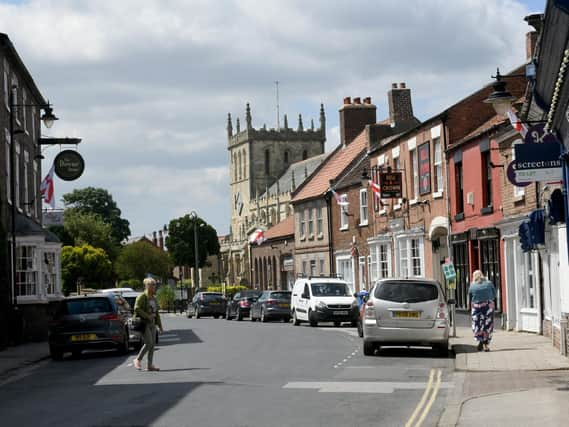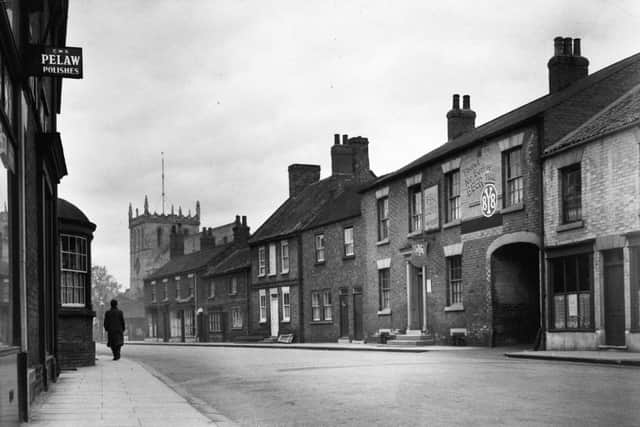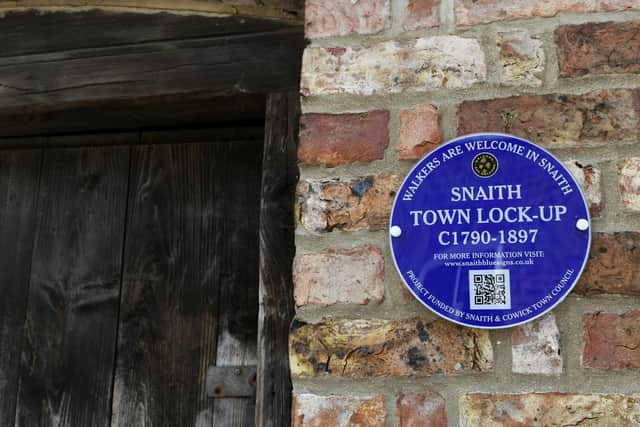From Gothic architecture to Yorkshire Ales, there's a lot to enjoy in Snaith


Like so many of Yorkshire’s small market towns, Snaith has a long and interesting history that belies its size and stature today.
Although it’s known that there were settlements in the area in the Anglo-Saxon period and there are brief references to Snaith in the Domesday book, at that time the land was owned by the crown because of its close proximity to Hatfield Chase, a vast royal hunting ground.
Advertisement
Hide AdAdvertisement
Hide AdOn our recent walk, which covered a six-mile loop from the town centre and out towards the south and east of Snaith, I was astonished to be able to see the remains of a royal hunting lodge called King’s Manor Moat and read about its history on an information board.


It occupies land south of the neighbouring village of East Cowick, although the M62 motorway now sits between the path we followed and King’s Manor Moat. However, it offers a great vantage point across to the site and, with the help of the board, you get a sense of its original layout.
King’s Manor Moat is said to date back to around 1320, although evidence suggests that the moat was dug around the buildings of an existing complex. It’s possible that this was an earlier hunting lodge as King John is known to have hunted in the area.
In 1295, Edward I gave the Manor of Cowick, as the area was then known, to Henry de Lacy. It then passed into Crown ownership again in 1322 during the reign of Edward II, who stayed at Cowick frequently during his visits to Yorkshire.


Advertisement
Hide AdAdvertisement
Hide AdHe is said to have carried out extensive renovations at the manor house, including the excavation of the moat around the inner court. Records suggest that he spent £200 on improvements, including tiling the roof and installing fireplaces.
Edward III spent a further £140 on the house and then gifted it to his mother, Queen Isabella, in 1327, and later to his Queen, Philippa. By the Tudor period, the manor house is said to have been in a ‘ruinous’ state and the seat of the Manor of Cowick was relocated 600 metres away to Cowick Hall. The moated site was abandoned sometime after this.
Today, the 17th-century, Grade 1-listed Cowick Hall is the corporate headquarters of chemical company Croda International, but its grounds are open for members of the public to explore.
In fact, the walking route that we followed – one of several that pass through the site – emerged to the rear of the hall in an attractive area that’s managed for wildlife. We enjoyed a brief picnic stop by the ponds with our children before heading on through the more formal grounds surrounding the hall itself.
Advertisement
Hide AdAdvertisement
Hide AdThe town of Snaith as we know it today really sprang up around the Priory Church of St Laurence, which still dominates the town centre. Around the year 1100, the rectory of Snaith was given to the Archbishop of York, who, in turn, gave it to the Benedictine abbey at nearby Selby.
In 1310, William Greenfield, the Archbishop of York, pronounced that the Abbot and convent of Selby should be allowed ‘to place two of their monks in the church of Snaith to be continually resident’.
This small cell of Benedictine monks remained at Snaith until the dissolution of the monasteries by Henry VIII in the 16th century. Snaith Priory is open to visitors on Mondays, Wednesdays and Saturdays.
Other interesting landmarks in the town centre include the ‘lock-up’, which is located next to the Priory and was apparently use to detain petty criminals on market days, and the Old Grammar School, which was the first school to be built in Snaith and stands in the grounds of the Priory.
Advertisement
Hide AdAdvertisement
Hide AdLocated nearby, Old Mill Brewery is an independent, family-owned brewery established in 1983 and housed in a charming 18th-century, former corn mill turned clog factory.
Visitors to Snaith can take a tour of the traditional brewhouse and fermenting room to see the brewing process first-hand, but must book in advance via the website. Now a residential care home, Snaith Hall was built by a prominent local family of solicitors and landowners around 1829.
It was well-known locally for its elegant conservatory, which was added to the house in the mid-19th century and attributed to Joseph Paxton, who designed the Crystal Palace, in London.
Today, much of Snaith town centre is a Conservation Area and, although there are many fine examples of Georgian architecture, some properties are far older. One of the oldest can be found on the corner of Beast Fair and dates back to 1627.
Advertisement
Hide AdAdvertisement
Hide AdDefining moments in history that shaped the area include the draining of Hatfield Chase by Cornelius Vermuyden, which began in 1626 and made it possible for the surrounding land to be cultivated, and an Act of Parliament passed in 1776 that allowed Thomas Stapleton of Carlton to build Carlton Toll Bridge over the River Aire, at a cost of £1,850.
Our walk around Snaith afforded us occasional glimpses of the striking clock tower of Carlton Towers, a grand country house sitting in 250 acres of parkland, which looks Victorian at first glance but can trace its origins back to the 14th century.
The home of Lord and Lady Gerald Fitzalan Howard, it has a breathtakingly beautiful Gothic Revival interior.
These days it operates as a wedding and events venue, but also has its own vineyard and tearoom. Most Sundays it hosts an outdoor market that has become increasingly popular among local traders and shoppers alike.
Advertisement
Hide AdAdvertisement
Hide AdIn recent months Snaith’s town centre has been buoyed by the opening of a number of new ventures, including The Fruit Tree, where you can buy fruit, vegetables, pulses, nuts, seeds and much more by weight and use your own reusable container, and Snaith Chippy, a traditional fish and chip shop and restaurant offering fresh seafood platters too.
These new ventures sit alongside more established local businesses, such as Kitchen, which is famed for cakes and pastries; J Punton and Son, an independently owned DIY store; and Yorkshire Ales, which has steadily evolved from a tiny bottle shop into a popular pub with its own function room and beer garden, having expanded into the former Moot Hall.
Snaith serves a predominantly local crowd of shoppers from the surrounding villages and rural areas, but visitors exploring for the first time could easily while away a pleasant morning or afternoon there.
Comment Guidelines
National World encourages reader discussion on our stories. User feedback, insights and back-and-forth exchanges add a rich layer of context to reporting. Please review our Community Guidelines before commenting.
